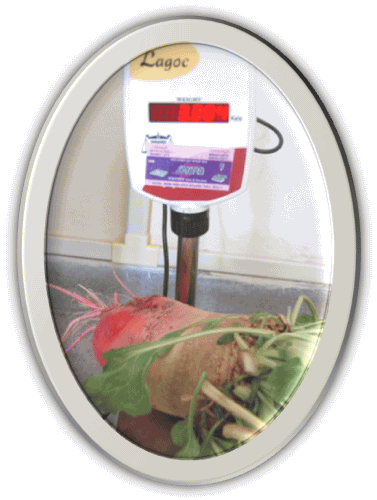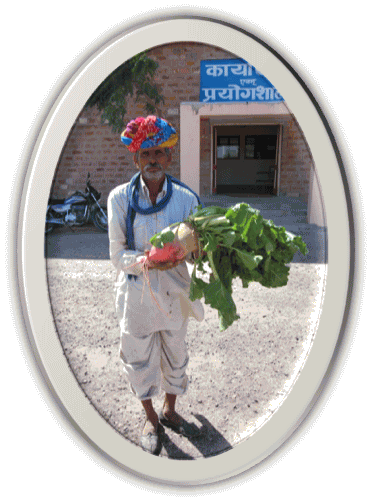चारा बीट - एक उत्कृष्ट चारा फसल
Fodder beet (Beta vulgaris sub sp. maritime) is considered to be one of the highest biomass producing crop and cultivated globally mainly for its fleshy, swollen roots. The major fodder beet producing countries are France, United Kingdom, Netherland, New Zealand, Belarus, China, Japan.
The plant is similar to sugar beet but its roots are less deeply buried (upto 2/3 above ground) and the dark green heart shaped leaves are borne in a rosette lying more horizontally (Fig.1).
It has an inherent capacity of salt tolerance and probably the highest biomass producing crop in saline environments. Fodder beets provide excellent quality fodder (Table 1). It is energy rich highly palatable and digestible fodder.
Studies revealed that feeding fodder beet roots can maintain animal productivity, to save about 50% of ration concentrate feed mixture and increased milk yield and its component.
Recently, Fodder bee has been introduced in India and some trials were conducted by Central Arid Zone Research Institute, State Agriculture Departments of Gujarat, Maharashtra and Madhya Pradesh, and few seed companies. In almost all the places, the biomass production of this crop was many times higher than other fodder crops of the region.
A great response was received from the farmers. With the strengthening of Dairy Industry, farmers have now started rearing high yielding animals i.e. cross bred cattle and buffalos for which green fodder is a must. A negative energy balance is recorded in these high yielding animals along with multi nutrient deficiencies in many regions.
This is mainly due to unavailability of fresh forage and hence their full yield potential is not realized. Fodder beet makes fodder available during March to June when the availability of other fresh fodder crops such as oat, Lucerne and berseem tend to decline. Comparatively its water requirement is less than these crops.
With the introduction of better varieties it can now be cultivated in almost all types of climate i.e. temperate, tropical and sub-tropical during winters. It can be grown on almost all types of soil but deep well drained loam soils are best. Beet should not be grown on acid soils. As the crop is new an attempt has been made here to provide package of practices for growing this crop.
Fig.1. Fodder beet crop
Table 1 : Proximate analysis of Fodder beet
|
Dry matter (%) |
Crude Protien (%) |
Fat (%) |
Fiber (%) |
Ca (%) |
P (%) |
|
|
Root |
17 |
5.7 |
0.8 |
3.6 |
0.1 |
0.1 |
|
Leaves |
12 |
16.5 |
2.7 |
25 |
0.8 |
0.2 |
Varieties of fodder beat:
J K Kuber, Jomon, Splendide.
Land preparation:
As the seed of this crop is small, a fine tilth is required for its sowing. A deep ploughing with disc plough or MB plough (depending on soil type) followed by two cross harrowing should be done. Afterwards make ridges of 40 cm width, 15 cm high and furrows of 30 cm with a ridge maker.
Seed & sowing of fodder beat :
It can be sown from October to December. Seeds should be sown manually on the top of ridges with 2 seeds per hill at 20 cm distance and depth of 2-4 cm. About 2-2.5 kg seed /hectare is required. After sowing, immediately irrigate the field in furrows and care should be taken not to let water flow over the ridges.
Manures and Fertilizers:
It is a heavy feeder and hence respond very well to nutrient application. Apply 25-40 tonnes FYM/ha during land preparation. Nitrogen, phosphorus and potash should be applied @ 150:75:150 kg/ha. sulphur and Zinc @ 30 and 25 kg/ha should also be applied if soils are deficient in them.
Full dose of phosphorus, potash, sulphur and zinc along with half of nitrogen should be applied basal. Remaining half of the nitrogen should be top dressed in two equal doses after each hand weeding at 30 & 50 days after sowing.
Weeding and thinning:
As most of the fodder beet varieties are multi germ , more than one seedling may emerge from single seed . So all the extra seedling except one per hill at a distance of 20 cm spacing should be removed and where required gap filling should be done. The growth of fodder beet plants is very slow during first 2 months, therefore it is essential to keep the crop weed free during this time. Manual weeding along with earthing up should be done at 30 and 50 days after sowing.
Irrigation:
First irrigation should be given immediately after sowing and then it requires approximately 4-6 irrigations at two weeks interval. It can tolerate poor quality water also, but it should be given with care so than soil does not deteriorate.
Diseases & Insect pest
Although not much disease infestation occur but care should be taken for root rot (Sclerotium rolfsii) and foliage damaging insects. Seeds are supplied with standard fungicide and insecticide treatments, still if needed seed treatment with Trichoderma viride powder @ 1.25 kg/ha can be done against root rot. For insects, apply foliar spray of 5% Neem seed Kernel extract at the time of bulking.
Harvesting
The leaves can be cut 2-3 inches above the root portion 50 days before harvesting of roots and then apply nitrogen @ 25 kg/ha for faster re growth. Fodder beet roots can be harvested when physiological maturity is reached i.e. when basal leaves start drying.
Normally it is start 120 days after sowing. However, as the roots do not spoil in the soil, early harvest is not necessary. Care should be taken not to bruise the skin of roots while digging out.
Feeding to animals.
Cleaned roots and leaves can be fed directly to the animals. Dairy animals can be fed fresh fodder beet along with leaf @ 10-15 kg/animal/day (3-4 kg dry matter) with other green and dry fodder materials. A one week transition with 1 kg (dry matter) roots is recommended.
Over doses may cause bloat. For sheep and goat 4-7 kg/animal/day fresh beet is optimum. This can be feed to pigs also. Roots can be chopped and mixed with concentrates or dry fodder. It can be stored by sun drying chopped roots and then fed to animals afterwards mixed in concentrates.
Crop rotation:
Fodder beet should not be grown every year on the same field. It can be grown in rotation with cowpea, clusterbean, pearlmillet in kharif and oat and berseem in rabi.
Yield :
The individual root size varies from 2.5 -4.5 kg. Bigger than this size are also not uncommon. About 20% of fodder is received as leaf foliage. Average fresh fodder yield after following these standard practices varies from 65-100 tonnes/ha.




